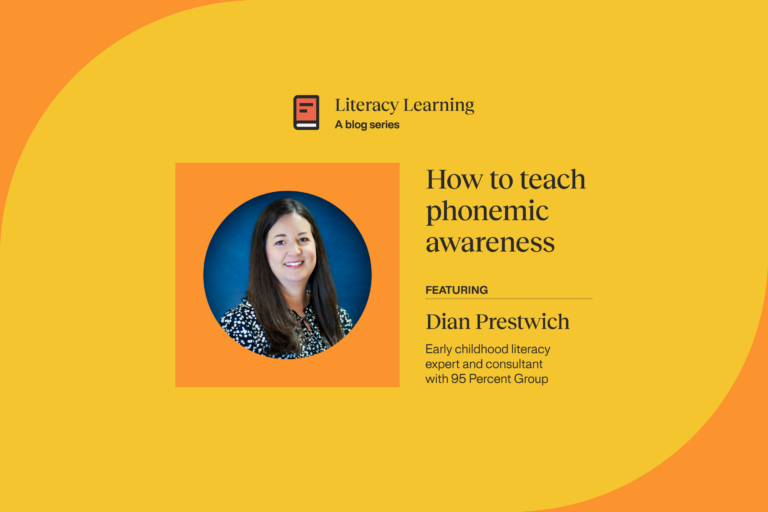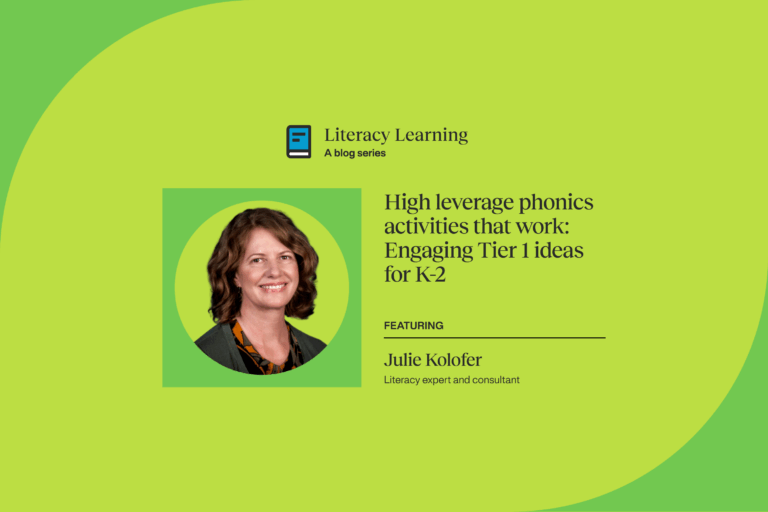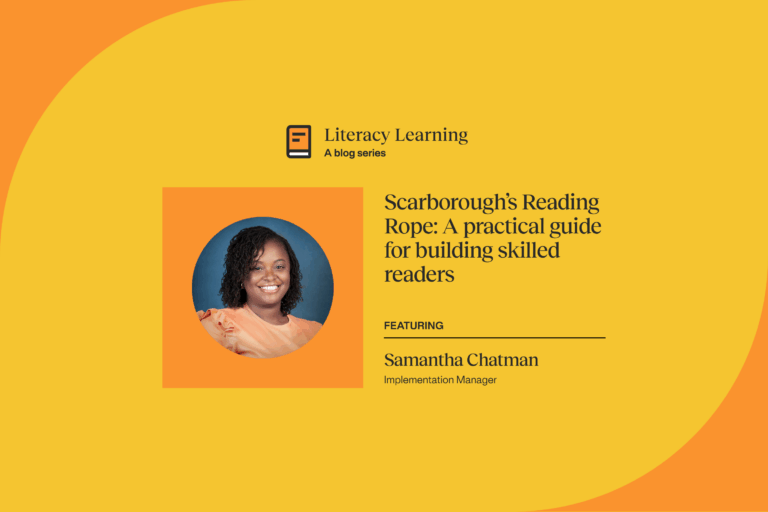How to teach phonemic awareness: Building the blocks of reading success
A post from our Literacy Learning: Science of reading blog series written by teachers, for teachers, this series provides educators with the knowledge and best practices needed to sharpen their skills and bring effective science of reading-informed strategies to the classroom.

Research has given us a clear understanding of the important role phonemic awareness instruction plays in foundational reading development. In fact, the discovery of this phonological deficit in struggling readers is one of the most powerful advances in reading science. According to the Report of the National Reading Panel (2000), all children in K-1 should receive instruction in phonemic awareness in addition to phonics.
Phonemic awareness is a subset of phonological awareness and refers to the ability to identify and sequence the individual sounds in spoken words. For example, “cat” has three phonemes (/k/ /a/ /t/) and “shoe” has two (/sh/ /oo/).
…When it comes to a correlation with reading and spelling, it’s the work at the phoneme level that’s truly important, especially blending, isolating, segmenting.
Dian Prestwich
Why teach phonemic awareness?
Phonemic awareness instruction teaches readers to attend to the individual sounds that make up words. This is key for learning how letters (graphemes) and sounds (phonemes) work together in phonics. It also helps readers activate working memory to store the words they’ve already sounded out.
In addition, research shows that skills shouldn’t necessarily be taught in isolation, but that students improve significantly when their lessons cover both phonemic awareness and phonics, compared to just focusing one or the other on its own.
When the The Report of the National Reading Panel was published in 2000, the recommendation was that children should receive effective phonemic awareness instruction in small daily doses. Since then, we have come to see that when they do, it improves their ability to read and spell familiar and unfamiliar words (Ehri,2004).
Literacy expert and 95 Percent Group professional learning consultant, Dian Prestwich, weighed in on this topic. “The most common deficits among struggling readers tend to be phonological processing—within which phonemic awareness plays a big role. Explicit instruction early in schooling means less of a chance of struggle later on.”
“The thing about phonemic awareness instruction,” Prestwich added, “is that it is the foundation of so many aspects of literacy. When kids can more easily manipulate, isolate, and work with sounds in words, they will be stronger readers and spellers.”
Essential phonemic awareness skills
Looking at the scope of phonemic awareness skills, we understand that there is a sequence that begins with teaching skills that are easier for emerging readers, and gradually become more advanced. Often though, instead of teaching all skills to all students, it makes more sense to use a diagnostic approach to see what students might already know and what they still need to learn.
These are the phonemic awareness skills necessary for building a strong foundation in literacy:
- Phoneme isolation: Identifying the individual sound at the beginning of the word (initial phoneme), the end of the word (final phoneme), and then the sound in the middle of the word (medial).
- Phoneme blending: This means offering students a word broken into phonemes (say the sounds /k/-/a/-/t/). Then ask students to blend the phonemes and say the whole word, “cat.”
- Phoneme segmentation: The “opposite” of blending—say a word out loud (“cat”) and have students tell you what sounds are inside the word (/k/-/a/-/t/).
- Phoneme manipulation: This is addition, deletion, and substitution of phonemes within words. It’s important to note that while practicing manipulation of sounds with letters can be helpful to reading and spelling, these skills aren’t essential for mastery of phoneme awareness.
- Addition: adding a phoneme to an existing word. If you start with the word top, and you add /s/ to the beginning of the word, now you have the word stop. As students become more comfortable with this, they can add multiple phonemes simultaneously.
- Deletion: the opposite of addition. Instead of adding a phoneme, you take a phoneme away. So if you start with the word stop and you take away /s/, now you have the word top.
- Substitution: this is a bit like combining both addition and deletion. You first take away a phoneme and then add another—creating an entirely different word. If you start with the word cape, and delete the /k/ (leaving ape), and then you add /sh/, you end up with a completely new word: shape.
Prestwich emphasized the importance of students working at the phoneme level. “For a while in this work, the larger sound structures (syllable work, rime, and onset, etc.) were emphasized, but when it comes to a correlation with reading and spelling, it’s the work at the phoneme level that’s truly important, especially blending, isolating, segmenting.”
“As a coach,” she continued, “I saw that people began to pay attention to phonemic awareness and to teach these skills directly—because there was finally a way to do it. At this point, as we are all learning more about the importance of phonemic awareness, we now need to hone in on the critical details. We need to take it to the next level.”
Five engaging strategies for teaching phonemic awareness
There are many places you can find collections of phonemic awareness activities, but Prestwich highlighted that the cohesiveness of materials matters. “The consistency of language in the materials is important.” Prestwich offered, “When there is academic language that kids learn within the curriculum, use that language when you do an activity, and always use the same language and same routines and materials. This frees up cognitive space for the actual task.”
Some important strategic principles for effective phonemic awareness instruction:
- Screen for skills that your students already know: children often enter school in kindergarten with a wide range of language capabilities. It’s easy to use a diagnostic screener to understand which skills children have already mastered and which they still need instruction on.
- Deliver direct instruction in small doses: Students should be receiving short, daily instruction on these skills when they first enter school—most often pre-K or kindergarten.
- Use manipulatives to help anchor abstract concepts: Prestwich shared that having a chip kit, like the one included in the 95 Phonemic Awareness Suite™, so students can move an object around while segmenting and blending, can be a critical support tool for engagement with the concepts and for multisensory learning.
- Teach sounds in connection with letters. There’s long been this idea that phonemic awareness “can be taught in the dark.” While technically this is true, we now know that research supports phonemic awareness being taught in connection with letters or graphemes. The quicker you bring in the connection to the graphemes, the better students will learn their sound-letter correspondences and the concept of the alphabetic principle.
- Stick to the same routine and language for phonemic awareness every time: This means consistently doing things the same way for every phonemic awareness activity and using the same academic language you will be using within the lesson—for example, words like delete, isolate, etc. This way students don’t need to think about HOW to do something, rather they can focus on the actual learning.
Prestwich offers this advice for teachers who have reservations:
“Sometimes, teachers will push back on the logistics of having young students handle something like a chip kit. But these chips make a very abstract concept much more concrete for children—something to look at and to move when we are talking about manipulating a sound. Having something physical and tangible can make all the difference.”

Tips for teachers using manipulatives:
- Set aside a time at the beginning of the year just for establishing protocol for using the chips. Practice where to put things, etc. outside of the lesson so that you can save time during the actual lesson.
- Give only as many as they need. So if you are working with one vowel and two consonants, each student only needs 3 chips (instead of the whole bag).
- Partner students up with a mat or surface between them—then they can share the responsibility.
- Place the chips in one central location on the desk where they get their chips instead of digging in the bag.
- Number the chips: assign each child a number and they only use the chips with their number. This helps you to figure out who is losing their chips!
Looking for phonemic awareness lesson plans or specific activities for phonemic awareness instruction?
Putting it all together
We are in an era of increasing knowledge around how we teach children to read. This includes more research and knowledge about how to teach phonemic awareness. One of the most important things to understand is the importance of mastering these skills early on.
Phonemic awareness is a foundational skill: it is not something that kids in upper elementary school should still need to be working on—as long as explicit, direct instruction of phonemic awareness skills is happening in kindergarten, first, and second grade. These skills are very important and very teachable, and don’t need to take a lot of your literacy block. In fact, lessons can be completed in a short amount of time: 2 to 15 minutes depending on the needs.
95 Percent Group’s 95 Phonemic Awareness Suite™ offers a range of evidence-aligned products that can help support students from core instruction to intervention to assessment across Tier 1 and Tier 2.

Expert Biography
Dian Prestwich, early childhood literacy expert and consultant with 95 Percent Group
Dr. Dian Prestwich is currently a consultant for 95 Percent Group. In her consultant role, she provides professional development and coaching services to educators and administrators in schools across the county to improve student literacy outcomes. Dr. Prestwich has worked in the field of education since 1995, including 7 years at the University of Kansas as an Associate Teaching Professor, 6 years at the Colorado Department of Education (CDE) as the Assistant Director for the Office of Literacy, 9 years teaching the primary grades, and 5 years serving as an instructional coach. Dian also has 7 years of experience as a national trainer of Language Essentials for Teachers of Reading and Spelling (LETRS), LETRS Foundations, and LETRS for Early Childhood.
In addition to her role with 95 Percent Group, Dr. Prestwich serves as contributing faculty for Walden University’s Richard W. Riley College of Education & Leadership. Dr. Prestwich is also a member of the International Dyslexia Association (IDA) Accreditation Review Committee. In 2023, she served on the Praxis Early Childhood Development Advisory Committee (DAC) and National Advisory Committee (NAC).
Dian received her BA in Elementary Education from Northwestern State University and her Master of Education degree in Curriculum and Instruction from Lesley University. She earned her Doctor of Philosophy degree from Walden University in 2012. Her dissertation, Measuring Preschool Teachers’ Perceived Competency and Knowledge of Oral Language Development, included the development of an instrument to measure preschool teachers’ perceived competency and knowledge of strategies for language development.
Sources
- Ashby, Jane, Mount St. Joseph University, McBride,Marion, Barksdale Reading Institute, Naftel, Shira, Mount St. Joseph University, O’Brien,Ellen et al. “Teaching Phoneme Awareness in 2023: A Guide for Educators,” 2023. https://louisamoats.com/wp-content/uploads/2023/02/Teaching-PA-in-2023_A-Guide-for-Educators_1.30.23.pdf.
- Ehri, Linnea C. “Teaching Phonemic Awareness and Phonics: An Explanation of the National Reading Panel Meta-Analyses.” The Voice of Evidence in Reading Research. January 1, 2004, 153–86. https://psycnet.apa.org/record/2005-06977-008.
- Hulme, Charles, Bowyer-Crane, Claudine, Carroll,Julia M., Duff,Fiona J. and Snowling, Margaret J. “The Causal Role of Phoneme Awareness and Letter-Sound Knowledge in Learning to Read.” Psychological Science 23, no. 6 (2012): 572–77. https://doi.org/10.1177/0956797611435921.
- Kilpatrick, David A. Essentials of Assessing, Preventing, and Overcoming Reading Difficulties. John Wiley & Sons, 2015.



